Study on Physical Properties, Rheological Properties, and Self-Healing Properties of Epoxy Resin Modified Asphalt
Abstract
:1. Introduction
2. Materials and Methods
2.1. Materials
2.1.1. Base Asphalt
2.1.2. Epoxy Resin (ER)
2.2. Preparation of Epoxy Asphalt
2.3. Microscopic Test
2.3.1. Fluorescence Microscopy Test
2.3.2. Differential Thermal Analyzer Test
2.4. Macroscopic Test
2.4.1. Penetration Test
2.4.2. Ductility Test
2.4.3. Softening Point Test
2.4.4. Dynamic Shear Rheometer Test
3. Results and Discussion
3.1. Microscopic Analysis of Epoxy Asphalt
3.1.1. Fluorescence Microscopy Test Result
3.1.2. Glass Transition Temperature
3.2. Physical Properties of Epoxy Asphalt
3.3. Rheological Properties of Epoxy Asphalt
3.3.1. Complex Modulus and Phase Angle
3.3.2. Complex Viscosity
3.4. Self-Healing Properties of Epoxy Asphalt
3.4.1. Flow Behavior Factors
3.4.2. Flow Activation Energy
4. Conclusions
Author Contributions
Funding
Institutional Review Board Statement
Informed Consent Statement
Data Availability Statement
Conflicts of Interest
References
- Zhong, K.; Yang, X.; Luo, S.J.C. Performance evaluation of petroleum bitumen binders and mixtures modified by natural rock asphalt from Xinjiang China. Constr. Build. Mater. 2017, 154, 623–631. [Google Scholar] [CrossRef]
- Kırbaş, U.; Karaşahin, M. Investigation of ride comfort limits on urban asphalt concrete pavements. Int. J. Pavement Eng. 2018, 19, 949–955. [Google Scholar] [CrossRef]
- Zhang, F.; Zhang, L.; Muhammad, Y.; Cai, Z.; Guo, X.; Guo, Y.; Huang, K. Study on preparation and properties of new thermosetting epoxy asphalt. Constr. Build. Mater. 2021, 311, 125307. [Google Scholar] [CrossRef]
- Li, J.; Chen, F.; Yu, S.J. Experimental research on dynamic stability of asphalt mixture based on time-temperature equivalence principle. In Materials Science Forum; Trans Tech Publications Ltd.: Stafa-Zurich, Switzerland, 2018; pp. 287–293. [Google Scholar]
- Pouranian, M.R.; Imaninasab, R.; Shishehbor, M. The effect of temperature and stress level on the rutting performance of modified stone matrix asphalt. Road Mater. Pavement Des. 2020, 21, 1386–1398. [Google Scholar] [CrossRef]
- Ren, Z.; Zhu, Y.; Wu, Q.; Zhu, M.; Guo, F.; Yu, H.; Yu, J. Enhanced storage stability of different polymer modified asphalt binders through nano-montmorillonite modification. Nanomaterials 2020, 10, 641. [Google Scholar] [CrossRef]
- Cao, Z.; Huang, X.; Chen, M.; Yu, J.; Han, X.; Wang, R. Workability and rheological property evolution of active rejuvenated styrene–butadiene–styrene-modified bitumen in the early stage. ACS Sustain. Chem. Eng. 2020, 8, 19129–19139. [Google Scholar] [CrossRef]
- Han, X.; Mao, S.; Xu, S.; Yu, J.; Cao, Z.; Wang, R.; He, P.; Zeng, S. Effects of Reactive Chain Extension Rejuvenation Systems on the Viscosity–Temperature Characteristics, Rheological Properties, and Morphology of Aged Styrene–Butadiene–Styrene-Modified Bitumen. ACS Sustain. Chem. Eng. 2021, 9, 16474–16484. [Google Scholar] [CrossRef]
- Heitzman, M.A. State of the Practice: Design and Construction of Asphalt Paving Materials with Crumb-Rubber Modifier. Final Report; Office of Engineering, Federal Highway Administration: Washington, DC, USA, 1992. [Google Scholar]
- Lei, Y.; Wang, H.; Fini, E.H.; You, Z.; Yang, X.; Gao, J.; Dong, S.; Jiang, G. Evaluation of the effect of bio-oil on the high-temperature performance of rubber modified asphalt. Constr. Build. Mater. 2018, 191, 692–701. [Google Scholar] [CrossRef]
- Epps, J.A.; Mason, L. Uses of Recycled Rubber Tires in Highways: A Synthesis of Highway Practice. Final Report; National Cooperative Highway Research Program: Washington, DC, USA, 1994. [Google Scholar]
- Shu, X.; Huang, B. Recycling of waste tire rubber in asphalt and portland cement concrete: An overview. Constr. Build. Mater. 2014, 67, 217–224. [Google Scholar] [CrossRef]
- Sun, M.; Zheng, M.; Qu, G.; Yuan, K.; Bi, Y.; Wang, J. Performance of polyurethane modified asphalt and its mixtures. Constr. Build. Mater. 2018, 191, 386–397. [Google Scholar] [CrossRef]
- Zhang, F.; Li, J.; Yaseen, M.; Han, M.; Yin, Y.; Yang, S. Preparation methods and performance of modified asphalt using rubber–plastic alloy and its compounds. J. Mater. Civ. Eng. 2018, 30, 04018163. [Google Scholar] [CrossRef]
- Zhao, Z.; Wang, Z.; Wu, S.; Xie, J.; Yang, C.; Li, N.; Cui, P. Road performance, VOCs emission and economic benefit evaluation of asphalt mixture by incorporating steel slag and SBS/CR composite modified asphalt. Case Stud. Constr. Mater. 2023, 18, e01929. [Google Scholar] [CrossRef]
- Lv, Y.; Wu, S.; Li, N.; Cui, P.; Wang, H.; Amirkhanian, S.; Zhao, Z. Performance and VOCs emission inhibition of environmentally friendly rubber modified asphalt with UiO-66 MOFs. J. Clean. Prod. 2023, 385, 135633. [Google Scholar] [CrossRef]
- Sun, J.; Huang, W.; Lu, G.; Luo, S.; Li, Y. Investigation of the performance and micro-evolution mechanism of low-content thermosetting epoxy asphalt binder towards sustainable highway and bridge decks paving. J. Clean. Prod. 2023, 384, 135588. [Google Scholar] [CrossRef]
- Lu, Q.; Bors, J. Alternate uses of epoxy asphalt on bridge decks and roadways. Constr. Build. Mater. 2015, 78, 18–25. [Google Scholar] [CrossRef]
- Cong, P.; Tian, Y.; Liu, N.; Xu, P. Investigation of epoxy-resin-modified asphalt binder. J. Appl. Polym. Sci. 2016, 133, 43401. [Google Scholar] [CrossRef]
- Xiang, Q.; Xiao, F. Applications of epoxy materials in pavement engineering. Constr. Build. Mater. 2020, 235, 117529. [Google Scholar] [CrossRef]
- Li, Y.; Li, J.; Li, C.; Chen, A.; Bai, T.; Tang, S.; Wu, S.; Gao, Y.; Zhu, H.; Feng, J. Strength formation mechanism and performance of steel slag self-compacting epoxy resin concrete. Constr. Build. Mater. 2022, 359, 129525. [Google Scholar] [CrossRef]
- Sun, J.; Zhang, Z.; Ye, J.; Liu, H.; Wei, Y.; Zhang, D.; Li, X. Preparation and properties of polyurethane/epoxy-resin modified asphalt binders and mixtures using a bio-based curing agent. J. Clean. Prod. 2022, 380, 135030. [Google Scholar] [CrossRef]
- Zhang, Y.; Sun, Y.; Xu, K.; Yuan, Z.; Zhang, J.; Chen, R.; Xie, H.; Cheng, R. Brucite modified epoxy mortar binders: Flame retardancy, thermal and mechanical characterization. Constr. Build. Mater. 2015, 93, 1089–1096. [Google Scholar] [CrossRef]
- Xu, K.; Chen, R.; Wang, C.; Sun, Y.; Zhang, J.; Liu, Y.; Xie, H.; Cheng, R. Organomontmorillonite-modified soybean oil-based polyurethane/epoxy resin interpenetrating polymer networks (IPNs). J. Therm. Anal. Calorim. 2016, 126, 1253–1260. [Google Scholar] [CrossRef]
- Luo, Z.; Liu, T.; Wu, Y.; Yuan, H.; Qian, G.; Meng, X.; Cai, J. Study on Epoxy Resin-Modified Asphalt Binders with Improved Low-Temperature Performance. Adv. Civ. Eng. 2021, 2021, 5513338. [Google Scholar] [CrossRef]
- Zhao, R.; Jing, F.; Wang, R.; Cai, J.; Zhang, J.; Wang, Q.; Xie, H. Influence of oligomer content on viscosity and dynamic mechanical properties of epoxy asphalt binders. Constr. Build. Mater. 2022, 338, 127524. [Google Scholar] [CrossRef]
- Lu, Q. Research on the Structure and Tests of Epoxy Asphalt Surfacing for Steel Deck Bridges. Ph.D. Thesis, Southeast University, Nanjing, China, 2000. [Google Scholar]
- Wei, J.; Zhang, Y. Study on the Curing Process of Epoxy Asphalt; ASTM International: West Conshohocken, PA, USA, 2012. [Google Scholar]
- Yu, X.; Dong, F.; Ding, G.; Liu, S.; Shen, S. Rheological and microstructural properties of foamed epoxy asphalt. Constr. Build. Mater. 2016, 114, 215–222. [Google Scholar] [CrossRef]
- Berahim, H.; Sirait, K.; Soesianto, F. A new performance of RTV Epoxy Resin Insulation material in tropical climate. In Proceedings of the 7th International Conference on Properties and Applications of Dielectric Materials (Cat. No. 03CH37417), Nagoya, Japan, 1–5 June 2003; pp. 607–610. [Google Scholar]
- Nazzal, M.D.; Kim, S.S.; Abbas, A.R.; Qtaish, L.A.; Holcombe, E.; Hassan, Y.A. Fundamental Evaluation of the Interaction between RAS/RAP and Virgin Asphalt Binders; Ohio Dept. of Transportation: Columbus, OH, USA, 2017. [Google Scholar]
- Chen, Z.; Wu, S.; Xiao, Y.; Zeng, W.; Yi, M.; Wan, J. Effect of hydration and silicone resin on Basic Oxygen Furnace slag and its asphalt mixture. J. Clean. Prod. 2016, 112, 392–400. [Google Scholar] [CrossRef]
- Yang, C.; Wu, S.; Cui, P.; Amirkhanian, S.; Zhao, Z.; Wang, F.; Zhang, L.; Wei, M.; Zhou, X.; Xie, J. Performance characterization and enhancement mechanism of recycled asphalt mixtures involving high RAP content and steel slag. J. Clean. Prod. 2022, 336, 130484. [Google Scholar] [CrossRef]
- Li, J.; Yu, J.; Wu, S.; Xie, J. The Mechanical Resistance of Asphalt Mixture with Steel Slag to Deformation and Skid Degradation Based on Laboratory Accelerated Heavy Loading Test. Materials 2022, 15, 911. [Google Scholar] [CrossRef]
- Yang, C.; Wu, S.; Xie, J.; Amirkhanian, S.; Zhao, Z.; Xu, H.; Wang, F.; Zhang, L. Development of blending model for RAP and virgin asphalt in recycled asphalt mixtures via a micron-Fe3O4 tracer. J. Clean. Prod. 2023, 383, 135407. [Google Scholar] [CrossRef]
- Liu, Q.; Wan, Y.; Schlangen, E.; van Bochove, G. Unravelling porous asphalt concrete with induction heating. Constr. Build. Mater. 2014, 71, 152–157. [Google Scholar] [CrossRef]
- Hager, M.; Greil, P.; Leyens, C.; Zwaag, S.; Schubert, U.S. Self-Healing Materials. Adv. Mater. 2010, 22, 5424–5430. [Google Scholar] [CrossRef]
- Dai, Q.; Wang, Z.; Hasan, M.R.M. Investigation of induction healing effects on electrically conductive asphalt mastic and asphalt concrete beams through fracture-healing tests. Constr. Build. Mater. 2013, 49, 729–737. [Google Scholar] [CrossRef]
- García, Á. Self-healing of open cracks in asphalt mastic. Fuel 2012, 93, 264–272. [Google Scholar] [CrossRef]
- Chao, L.; Shaopeng, W.; Guanyu, T.; Yue, X. Initial Self-Healing Temperatures of Asphalt Mastics Based on Flow Behavior Index. Materials 2018, 11, 250–257. [Google Scholar]
- Zhang, L.; Liu, Q.; Wu, S.; Rao, Y.; Sun, Y.; Xie, J.; Pan, P. Investigation of the flow and self-healing properties of UV aged asphalt binders. Constr. Build. Mater. 2018, 174, 401–409. [Google Scholar] [CrossRef]
- Tang, J.; Liu, Q.; Wu, S.; Ye, Q.; Sun, Y.; Schlangen, E. Investigation of the optimal self-healing temperatures and healing time of asphalt binders. Constr. Build. Mater. 2016, 113, 1029–1033. [Google Scholar] [CrossRef]
- Zhang, Z.; Liang, J.; Hu, J.; Li, J.; Ni, F. Characterizing the curing behavior and high-temperature performance of epoxy-resin modified asphalts. Constr. Build. Mater. 2022, 353, 129046. [Google Scholar] [CrossRef]
- Yang, C.; Xie, J.; Wu, S.; Amirkhanian, S.; Hu, R. Investigation of physicochemical and rheological properties of SARA components separated from bitumen. Constr. Build. Mater. 2020, 235, 117437. [Google Scholar] [CrossRef]
- Cong, P.; Chen, S.; Yu, J. Investigation of the properties of epoxy resin-modified asphalt mixtures for application to orthotropic bridge decks. J. Appl. Polym. Sci. 2011, 121, 2310–2316. [Google Scholar] [CrossRef]

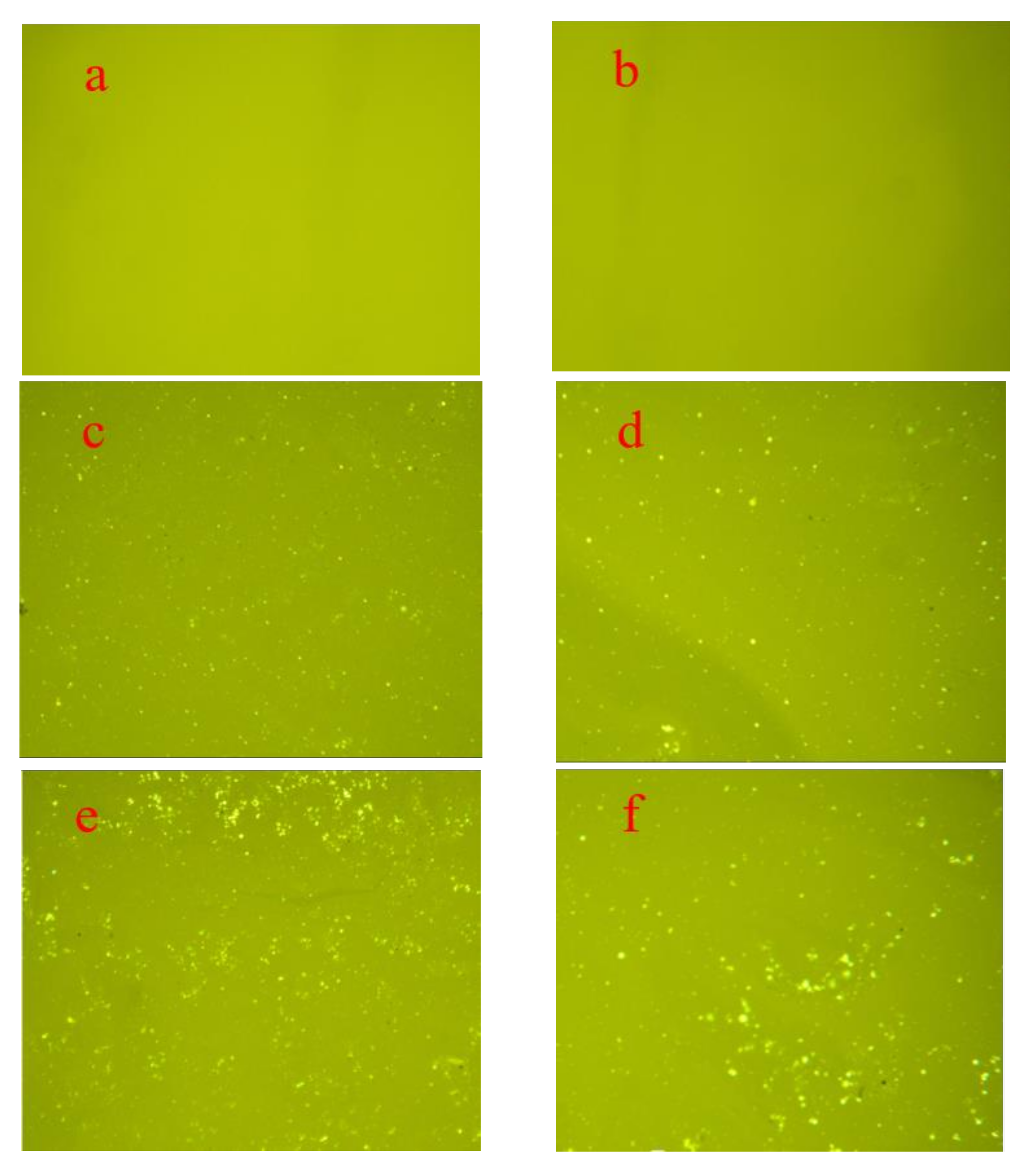
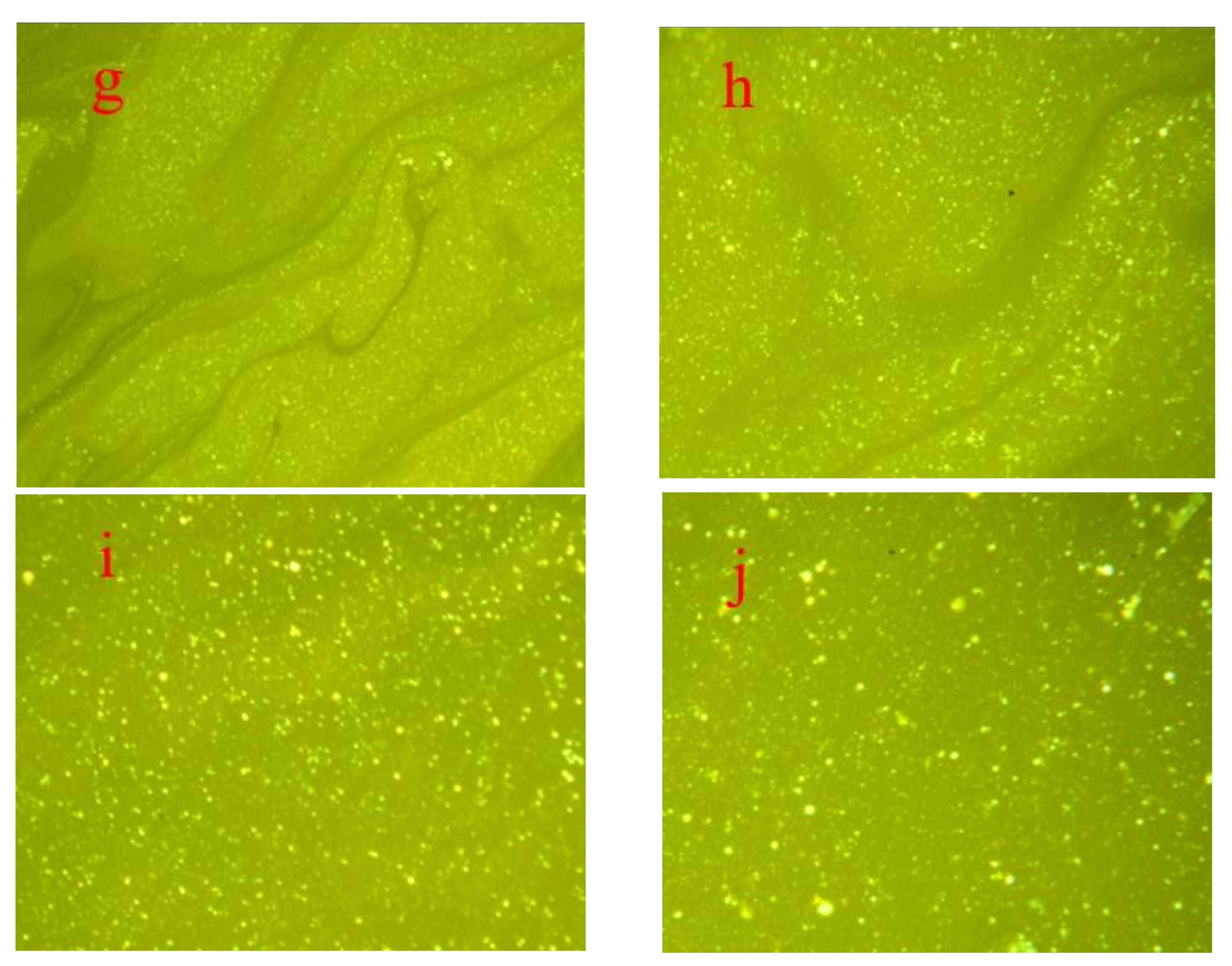
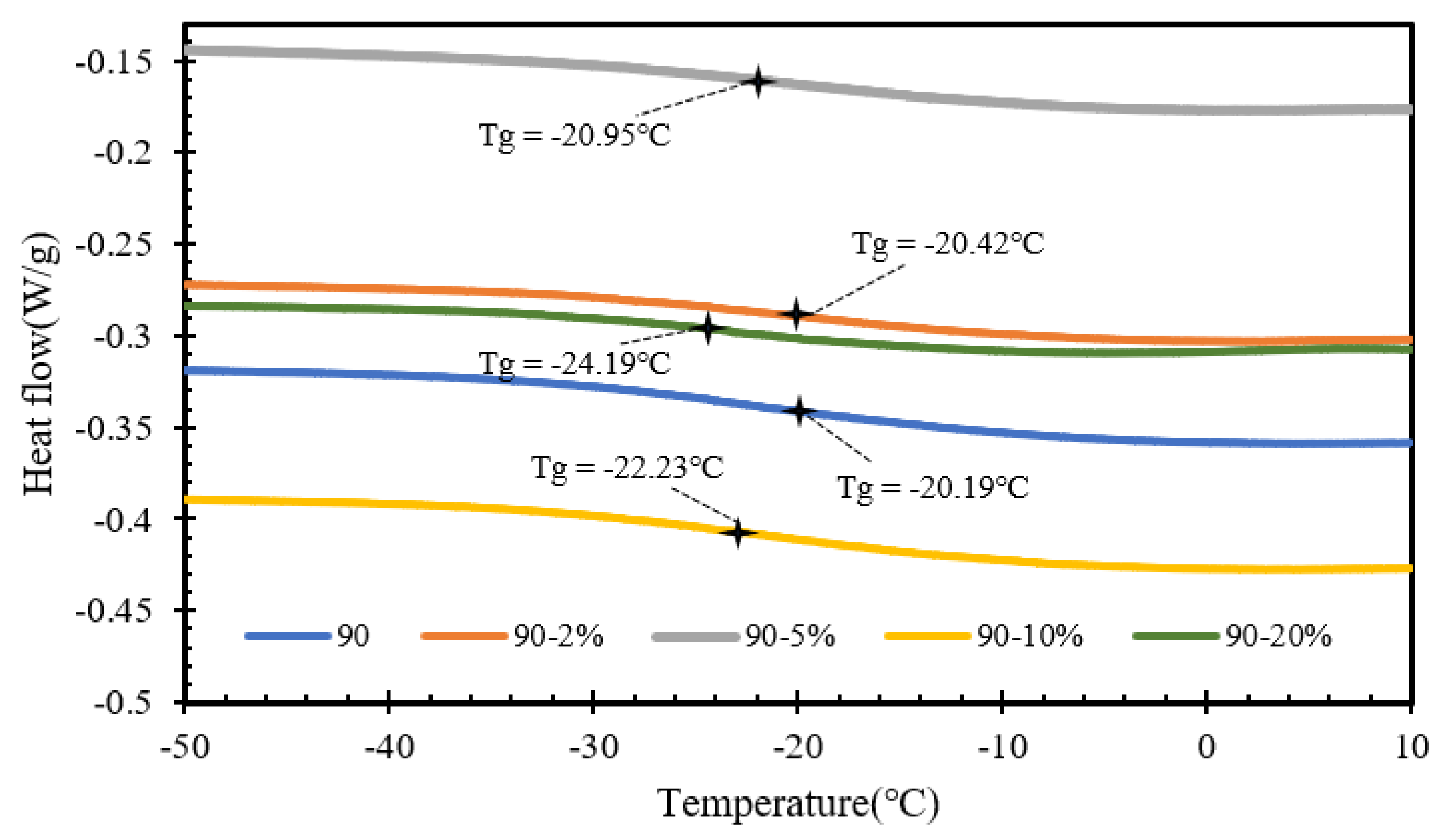
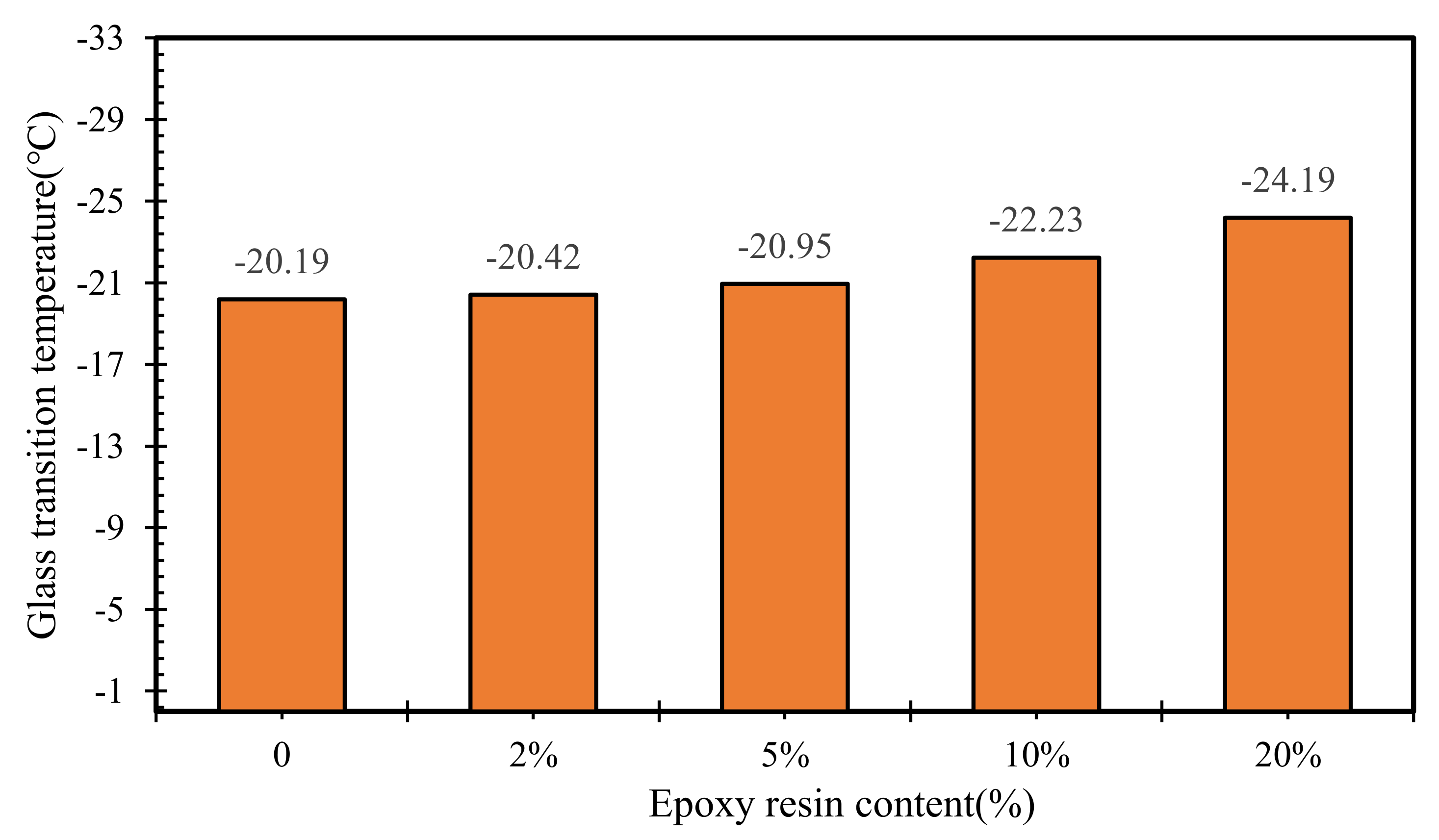


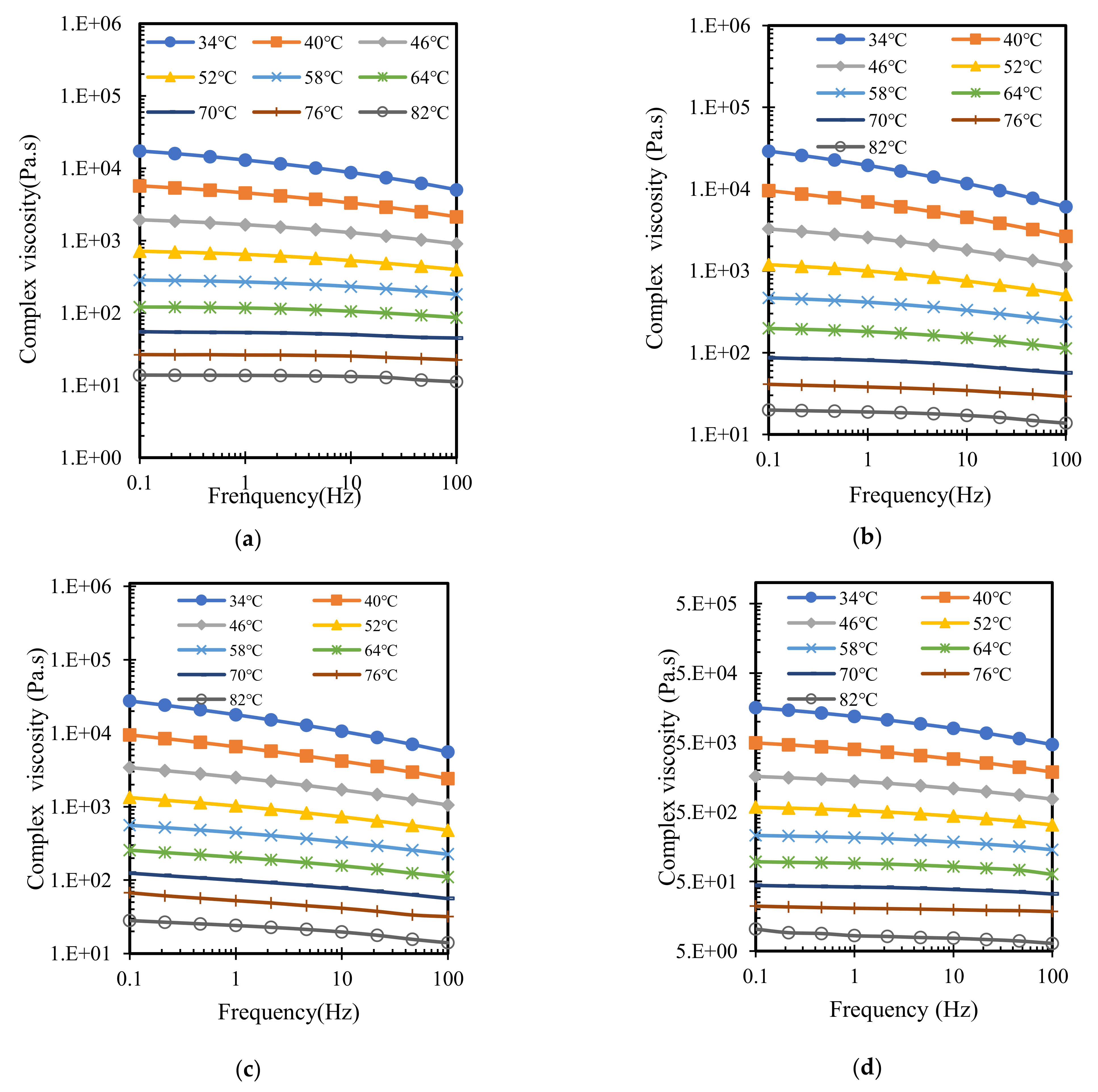
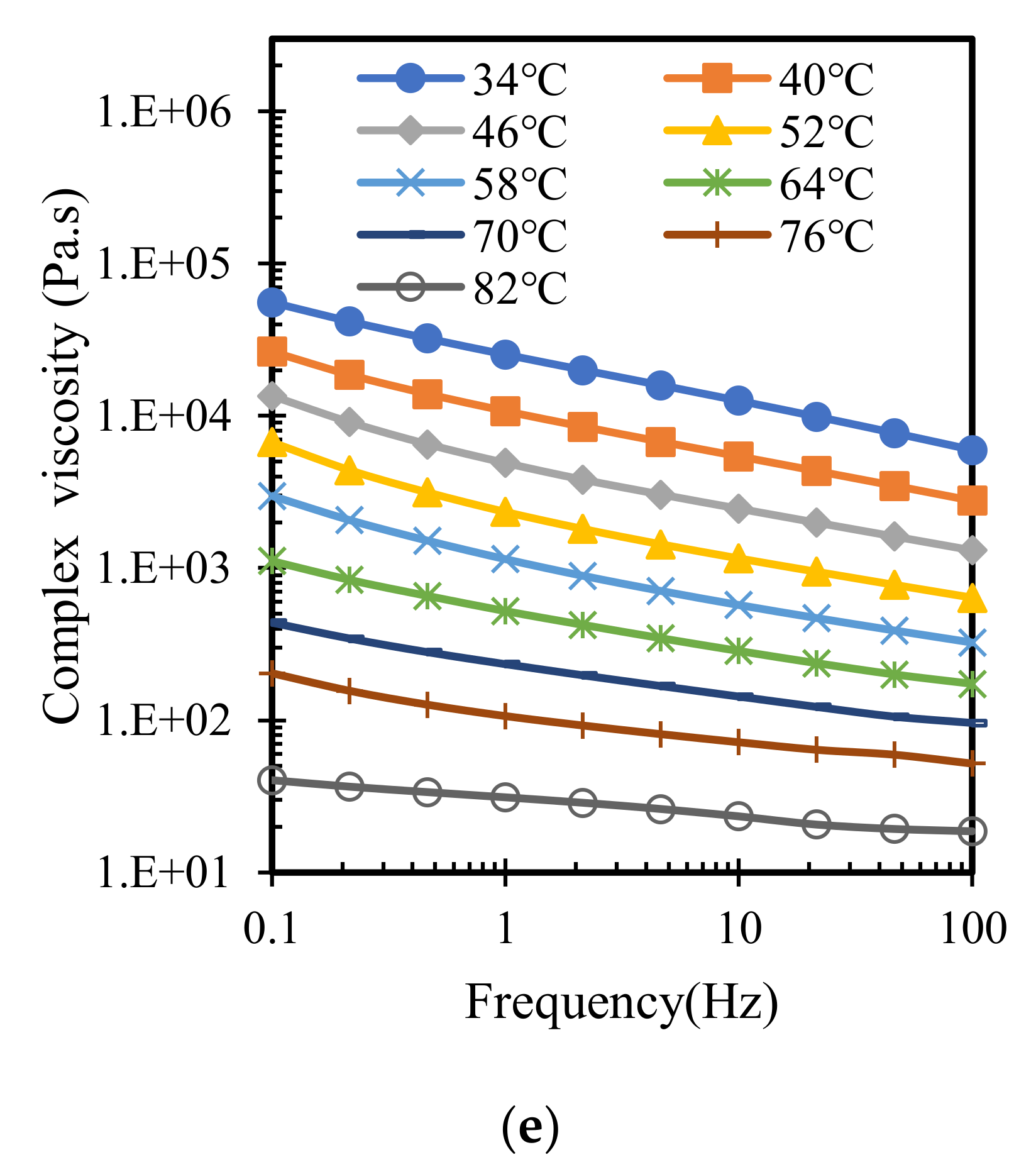
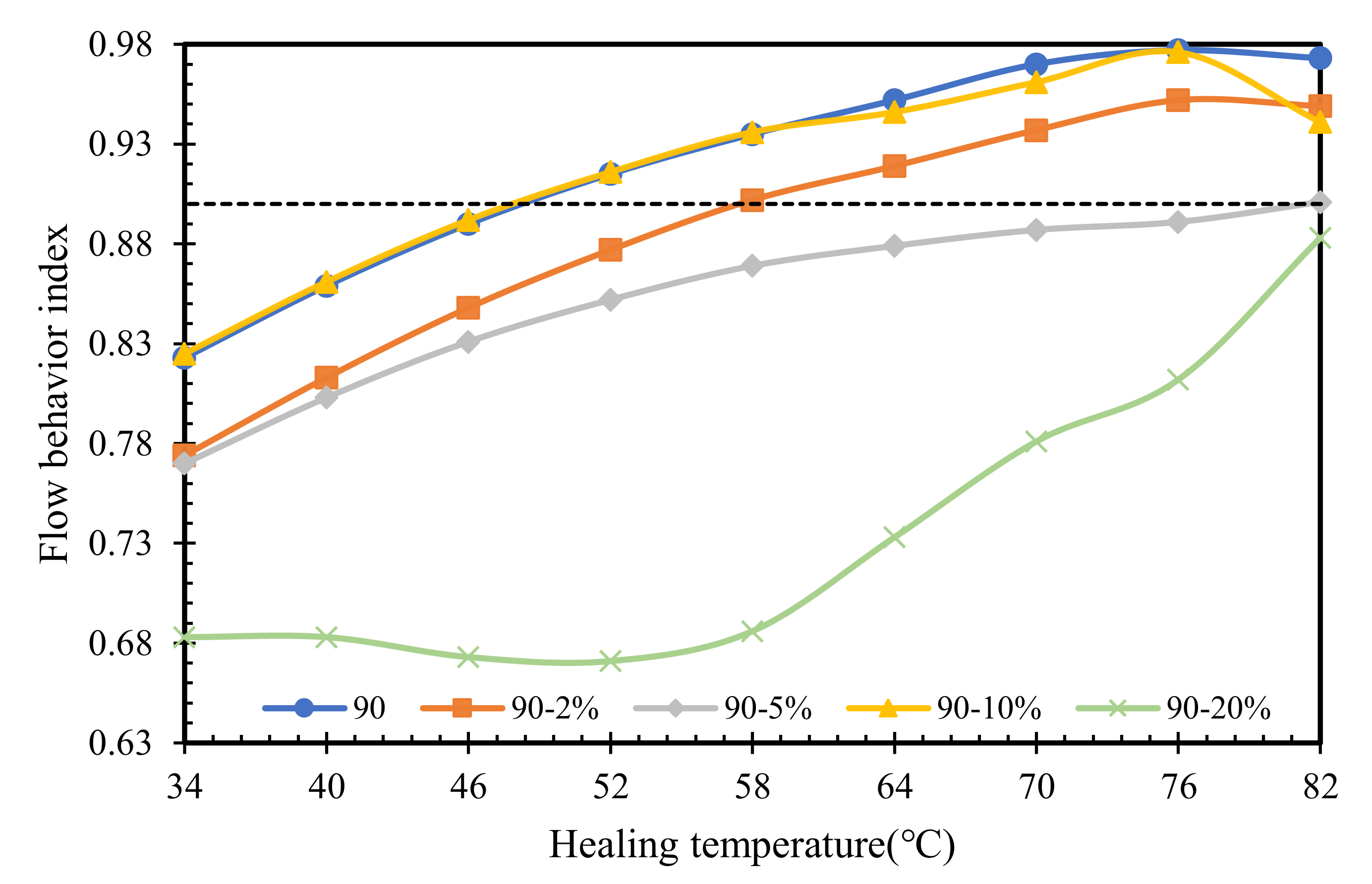
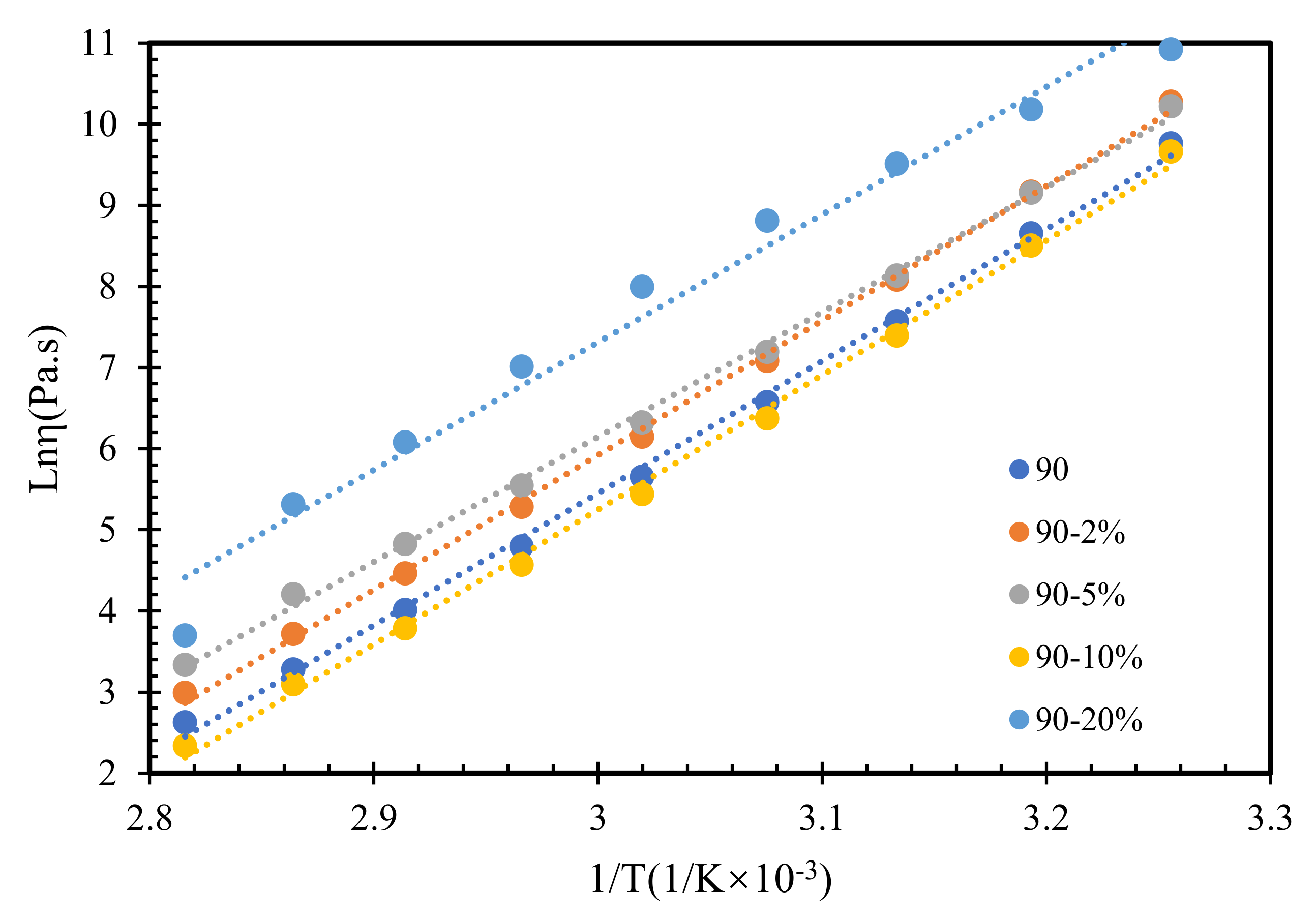

| Indexes | Experimental Method | Test Data |
|---|---|---|
| Penetration 25 °C (0.1 mm) | T0604 | 93.7 |
| Ductility, 5 cm/min, 15 °C (cm) | T0605 | >150 |
| Softening point (°C) | T0606 | 47.2 |
| Test | Experimental Method | Result |
|---|---|---|
| Viscosity (73 °C) (P.s) | ASTM D445 | 17,320 |
| Gardner Color Scale | ASTM D1544 | <1 |
| Water content (%) | ASTM D1744 | <0.5 |
| Proportion (g/eq) | ASTM D1475 | 0.51 |
| Material | Temperature | Fitting Formula (y = axb) | R2 | Flow Behavior Index | |
|---|---|---|---|---|---|
| A | b | ||||
| Value | Value | ||||
| 90 | 34 | 12,535 | −0.177 | 0.9814 | 0.823 |
| 40 | 4427.3 | −0.141 | 0.9794 | 0.859 | |
| 46 | 1608.5 | −0.110 | 0.9699 | 0.890 | |
| 52 | 625.5 | −0.085 | 0.9566 | 0.915 | |
| 58 | 260.7 | −0.065 | 0.9271 | 0.935 | |
| 64 | 114.3 | −0.048 | 0.8975 | 0.952 | |
| 70 | 52.8 | −0.030 | 0.9126 | 0.970 | |
| 76 | 25.9 | −0.023 | 0.8203 | 0.977 | |
| 82 | 13.535 | −0.027 | 0.7414 | 0.973 | |
| 90-2% | 34 | 18,758 | −0.226 | 0.9886 | 0.774 |
| 40 | 6687.8 | −0.187 | 0.9878 | 0.813 | |
| 46 | 2461.7 | −0.152 | 0.9815 | 0.848 | |
| 52 | 963.54 | −0.123 | 0.9726 | 0.877 | |
| 58 | 399.46 | −0.098 | 0.959 | 0.902 | |
| 64 | 175.23 | −0.081 | 0.9435 | 0.919 | |
| 70 | 78.7 | −0.063 | 0.9457 | 0.937 | |
| 76 | 37.6 | −0.048 | 0.9686 | 0.952 | |
| 82 | 18.5 | −0.051 | 0.908 | 0.949 | |
| 90-5% | 34 | 17,311 | −0.23 | 0.9924 | 0.77 |
| 40 | 6371.7 | −0.197 | 0.9931 | 0.803 | |
| 46 | 2431.7 | −0.169 | 0.9913 | 0.831 | |
| 52 | 995.6 | −0.148 | 0.9896 | 0.852 | |
| 58 | 432.01 | −0.131 | 0.9893 | 0.869 | |
| 64 | 200.93 | −0.121 | 0.9899 | 0.879 | |
| 70 | 98.4 | −0.113 | 0.9931 | 0.887 | |
| 76 | 52.4 | −0.109 | 0.9979 | 0.891 | |
| 82 | 23.58 | −0.099 | 0.969 | 0.901 | |
| 90-10% | 34 | 11,426 | −0.175 | 0.9814 | 0.825 |
| 40 | 3833.9 | −0.139 | 0.9797 | 0.861 | |
| 46 | 1347.9 | −0.108 | 0.9718 | 0.892 | |
| 52 | 512.35 | −0.084 | 0.9599 | 0.916 | |
| 58 | 208.31 | −0.064 | 0.9375 | 0.936 | |
| 64 | 89.4 | −0.054 | 0.8926 | 0.946 | |
| 70 | 41.3 | −0.039 | 0.9429 | 0.961 | |
| 76 | 20.78 | −0.024 | 0.9936 | 0.976 | |
| 82 | 8.6 | −0.059 | 0.9614 | 0.941 | |
| 90-20% | 34 | 25,809 | −0.317 | 0.9982 | 0.683 |
| 40 | 11,382 | −0.317 | 0.9885 | 0.683 | |
| 46 | 5371.5 | −0.327 | 0.9766 | 0.673 | |
| 52 | 2584.2 | −0.329 | 0.9715 | 0.671 | |
| 58 | 1237.5 | −0.314 | 0.9809 | 0.686 | |
| 64 | 546.11 | −0.267 | 0.9902 | 0.733 | |
| 70 | 243.04 | −0.219 | 0.9893 | 0.781 | |
| 76 | 114.7 | −0.188 | 0.9638 | 0.812 | |
| 82 | 30.9 | −0.117 | 0.9961 | 0.883 | |
| Material | Fitting Formula (y = ax + b) | R2 | Flow Activation Energy | |
|---|---|---|---|---|
| a | b | |||
| Value | Value | |||
| 90 | 16.281 | −43.394 | 0.9979 | 360.7777 |
| 90-2% | 16.584 | −43.883 | 0.9988 | 364.8433 |
| 90-5% | 15.395 | −40.042 | 0.9980 | 332.9092 |
| 90-10% | 16.592 | −44.529 | 0.9976 | 370.2141 |
| 90-20% | 15.737 | −39.900 | 0.9771 | 331.7286 |
Disclaimer/Publisher’s Note: The statements, opinions and data contained in all publications are solely those of the individual author(s) and contributor(s) and not of MDPI and/or the editor(s). MDPI and/or the editor(s) disclaim responsibility for any injury to people or property resulting from any ideas, methods, instructions or products referred to in the content. |
© 2023 by the authors. Licensee MDPI, Basel, Switzerland. This article is an open access article distributed under the terms and conditions of the Creative Commons Attribution (CC BY) license (https://creativecommons.org/licenses/by/4.0/).
Share and Cite
Li, J.; Zhu, Y.; Yu, J. Study on Physical Properties, Rheological Properties, and Self-Healing Properties of Epoxy Resin Modified Asphalt. Sustainability 2023, 15, 6889. https://doi.org/10.3390/su15086889
Li J, Zhu Y, Yu J. Study on Physical Properties, Rheological Properties, and Self-Healing Properties of Epoxy Resin Modified Asphalt. Sustainability. 2023; 15(8):6889. https://doi.org/10.3390/su15086889
Chicago/Turabian StyleLi, Jiasheng, Yaoyang Zhu, and Jianying Yu. 2023. "Study on Physical Properties, Rheological Properties, and Self-Healing Properties of Epoxy Resin Modified Asphalt" Sustainability 15, no. 8: 6889. https://doi.org/10.3390/su15086889





